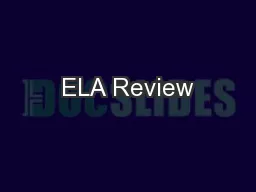

Figurative Language The Tipping Point Truce From The Tipping Point people are a type of exceptional peoplethey are energetic knowledgeable influential Law of the Few From The Tipping Point ID: 512210
Download Presentation The PPT/PDF document "ELA Review" is the property of its rightful owner. Permission is granted to download and print the materials on this web site for personal, non-commercial use only, and to display it on your personal computer provided you do not modify the materials and that you retain all copyright notices contained in the materials. By downloading content from our website, you accept the terms of this agreement.
Slide1
ELA Review
Figurative Language
The Tipping Point
TruceSlide2
From
The Tipping Point, ______ people are a type of exceptional people...they are energetic, knowledgeable, influential
Law of the FewSlide3
From
The Tipping Point, what is exponential growth?
When something grows at a rate proportional to the size of the populationSlide4
A fad is
short lived; a craze; widely shared enthusiasm for somethingSlide5
From
The Tipping Point, what is “a dramatic moment in an epidemic when everything changes all at once”?
a tipping pointSlide6
The Stickiness Factor is ______
A way to make a message memorableSlide7
_______ is an epidemic rule that emphasizes that humans are more sensitive to their environment than they realize.
The Power of ContextSlide8
Connectors are ______
rare people with large social networksSlide9
How does Paul Revere relate to concepts from the book
The Tipping Point?
He is a connector (and a salesman). He spread a word-of-mouth epidemicSlide10
Salesmen mostly focus on ______
Persuading peopleSlide11
A maven is ______
Someone who loves learning and sharing knowledgeSlide12
Name the countries on the two sides for World War I (Allies: _____, Other:___)
Allies: France, Belgium, Britain
Other: GermanySlide13
Estimate: How many people (soldiers and civilians) died in World War I?
over 14 millionSlide14
What is the name of Germany’s plan to first attach France via Belgium, then attack Russia?
The Schlieffen planSlide15
The study of writing or speaking for persuasion.
rhetoricSlide16
___________ is a logical appeal
LogosSlide17
An emotional appeal is called _____
PathosSlide18
Ethos is...
An appeal to establish credibility of the speaker or writerSlide19
____ is the author’s opinion about life, nature, or society.
ThemeSlide20
The author’s choice of words is _____
DictionSlide21
_____ goes against the main character (often the bad guy).
AntagonistSlide22
Plot
Sequence of events in a narrativeSlide23
What does it mean to “redress a wrong”?
To seek justice or revenge for something done to youSlide24
Define proportional
Equal to or equivalent; the same amountSlide25
Argumentation writing focuses on this _____ appeal.
Logos or logicalSlide26
A scene that interrupts the action of a work to show a previous event
FlashbackSlide27
The main character in a work; the character with whom the readers identify
ProtagonistSlide28
Words or phrases a writer uses to represent persons, objects, actions, feelings, and ideas descriptively by appealing to the senses
ImagerySlide29
A comparison of two different things or ideas through the use of the words “like” or “as”
simileSlide30
The use of hints or clues in a narrative to suggest future action
ForeshadowingSlide31
A reference in a literary work to a mythological, literary, or historical person, place, or thing
AllusionSlide32
Comparison between two seemingly unlike things that actually have something important in common
MetaphorSlide33
The way you feel when you read a story. The author purposefully writes a story to create this
MoodSlide34
The perspective from which a narrative is told
Point of viewSlide35
The practice of beginning several consecutive or neighboring words with the same sound
AlliterationSlide36
The use of any object, person, place, or action that has both meaning in itself and that stands for something larger than itself, such as quality, attitude, belief, or value
SymbolismSlide37
Imitative harmony; the use of words that mimic the sounds they describe
OnomatopoeiaSlide38
Name the strongest (1)
type of appeal in thiswar propaganda poster:
LogosSlide39
The kind of metaphor that gives human characteristics to inanimate objects or abstract ideas
PersonificationSlide40
A deliberate, extravagant, and often outrageous exaggeration
HyperboleSlide41
The writer’s or speaker’s attitude toward a subject, character, or audience
ToneSlide42
Name the strongest
appeal in this propaganda (pick 1):
PathosSlide43
“It made the school look like a museum.”
What literary device is this an example of?
SimileSlide44
“With nothing to block it, the wind flung wet gusts at me…There were several trees bleakly reaching into the fog.”
What literary device is this an example of?
PersonificationSlide45
“The tree was tremendous, an irate, steely black steeple beside the river.”
What literary device is this an example of?
MetaphorSlide46
“It had loomed in my memory as a huge long spike dominating the riverbank, forbidding as an artillery piece...”
What literary device is this an example of?
SimileSlide47
Imagery
“In through swinging doors I reached a marble foyer, and stopped at the foot of a long white marble flight of stairs. Although they were old stairs, the worn moons in the middle of each step were not very deep.”
What literary device is this an example of? Slide48
“She had a curious habit of prefacing everything she said with a soft sibilant sound.”
What literary device is this an example of?
AlliterationSlide49
Write a sentence including a simile, metaphor, and alliterationSlide50
Create a sentence with personification and onomatopoeiaSlide51
Q
A